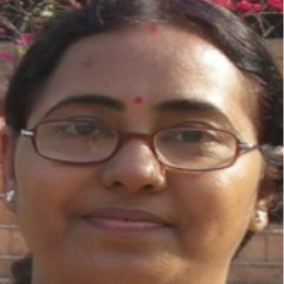
Sangita Roy
Work place: ECE Department, Narula Institute of Technology, India
E-mail: Indiaroysangita@gmail.com
Website:
Research Interests:
Biography
Sangita Roy is an Assistant Professor at ECE Department of Narula Institute of Technology under WBUT .She has a teaching experience of more than eighteen years. She was in Bells Controls Limited (instrumentation industry) for two years and West Bengal State Centre, IEI (Kolkata) in administration for two years. She completed her Diploma (ETCE), A.M.I.E (ECE) and M-Tech (Comm. Egg.). Currently perusing her PhD under Dr. Sheli Sinha Chaudhuri at ETCE Department of Jaduvpur University since 2012. She is the member of IEI, IETE, FOSET, ISOC, and IEEE ComSoc. She has published Journals as well as conference papers.
Author Articles
Modeling of Haze Image as Ill-Posed Inverse Problem & its Solution
By Sangita Roy Sheli Sinha Chaudhuri
DOI: https://doi.org/10.5815/ijmecs.2016.12.07, Pub. Date: 8 Dec. 2016
Visibility Improvement is a great challenge in early vision. Numerous methods have been experimented. As the subject is random and different significant parameters are involved to improve the vision, it becomes difficult, sometimes unsolvable. In the process original image has to be retrieved back from a degraded version of the image which is often difficult to perceive. Thus the problem becomes ill-posed Inverse Problem. This has been observed that VI (Visibility Improvement) is associated with haze and blur. This complex nature requires probability distribution, estimation, airlight calculation etc. In this paper a combination of haze and blur model has been proposed with detail discussions.
[...] Read more.Error Measurement & its Impact on Bilateral - Canny Edge Detector-A Hybrid Filter
By Sangita Roy Sheli Sinha Chaudhuri
DOI: https://doi.org/10.5815/ijmecs.2016.02.04, Pub. Date: 8 Feb. 2016
Image Processing, a subset of Computer Vision, is an important branch in modern technology. Edge detection is a subset of segmentation to detect object of interest. Different image edge detection filters and their evaluating parameters are introducing rapidly. But the performance of an edge detector is an open problem. In this paper different performance measures of edge detection have been discussed in details and their application on a hybrid filter using Bilateral and Canny is proposed. Its parametric performance has been evaluated and other well established or classical existing edge detecting filters have been compared with it to measure its efficiency.
[...] Read more.Nature-Inspired Swarm Intelligence and Its Applications
By Sangita Roy Samir Biswas Sheli Sinha Chaudhuri
DOI: https://doi.org/10.5815/ijmecs.2014.12.08, Pub. Date: 8 Dec. 2014
In 1989 Gerardo Beni and Jing Wang first proposed the name “Swarm Intelligence” in their paper “Swarm Intelligence in Cellular Robotic Systems”. Some remarkable observations of different researchers are studied in this paper, like the proximity principle, the quality principle, the principle of diverse response, the principle of stability, the principle of adaptability. To enhance the capabilities of robot and different systems, researchers started to exploit the behavior of natural systems. Swarm groups are governed by three rules, move in the same direction as your neighbor, remain close to your neighbor, and avoid collision with your neighbor .Characteristics of swarm groups are emergence and stigmergy. Different insects like ants, wasps, termites carry out a work locally for global goal with sufficient flexibility as they are not controlled centrally. In this paper the existing research works are analysed to show the behavior in social insects by using self-organization, positive feedback, negative feedback, amplification of fluctuation, multiple interactions. It has also been observed that these insects are almost blind and memoryless, still they communicate indirectly among themselves for stigmergic effect by using pheromone. Implementation of swarm intelligence in robotics i.e., swarm robots are narrated. The limitations of swarm robots as well as factors behind the success of swarm robotics have also been encompassed. Finally authors focus on swarm robots applications in telecommunication fields, civil engineering and digital image processing.
[...] Read more.Cuckoo Search Algorithm using Lèvy Flight: A Review
By Sangita Roy Sheli Sinha Chaudhuri
DOI: https://doi.org/10.5815/ijmecs.2013.12.02, Pub. Date: 8 Dec. 2013
Cuckoo Search (CS) is a new met heuristic algorithm. It is being used for solving optimization problem. It was developed in 2009 by Xin- She Yang and Susah Deb. Uniqueness of this algorithm is the obligatory brood parasitism behavior of some cuckoo species along with the Levy Flight behavior of some birds and fruit flies. Cuckoo Hashing to Modified CS have also been discussed in this paper. CS is also validated using some test functions. After that CS performance is compared with those of GAs and PSO. It has been shown that CS is superior with respect to GAs and PSO. At last, the effect of the experimental results are discussed and proposed for future research.
[...] Read more.Bio-inspired Ant Algorithms: A review
By Sangita Roy Sheli Sinha Chaudhuri
DOI: https://doi.org/10.5815/ijmecs.2013.04.04, Pub. Date: 8 Apr. 2013
Ant Algorithms are techniques for optimizing which were coined in the early 1990’s by M. Dorigo. The techniques were inspired by the foraging behavior of real ants in the nature. The focus of ant algorithms is to find approximate optimized problem solutions using artificial ants and their indirect decentralized communications using synthetic pheromones. In this paper, at first ant algorithms are described in details, then transforms to computational optimization techniques: the ACO metaheuristics and developed ACO algorithms. A comparative study of ant algorithms also carried out, followed by past and present trends in AAs applications. Future prospect in AAs also covered in this paper. Finally a comparison between AAs with well-established machine learning techniques were focused, so that combining with machine learning techniques hybrid, robust, novel algorithms could be produces for outstanding result in future.
[...] Read more.Other Articles
Subscribe to receive issue release notifications and newsletters from MECS Press journals